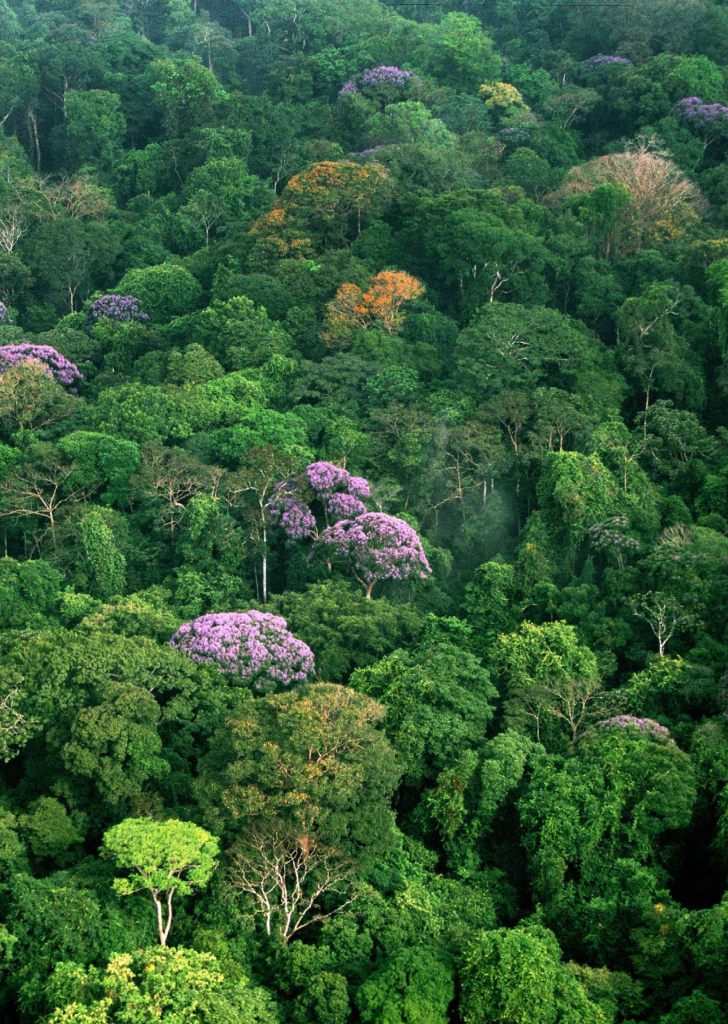
The tropical forest canopy is a vital component of our planet’s ecosystems, often referred to as the “lungs of the Earth” due to their immense capacity for carbon storage. Recent advancements in technology, such as the NASA GEDI study, have shed light on the significant impact of climate change on the health of these forests. By measuring forest canopy height, researchers are able to gauge the overall vitality and resilience of tropical forests, which play a critical role in regulating the global climate. As the study demonstrates, factors like heat and drought critically affect the health and structure of these high canopies. Understanding these dynamics is essential for both conservation efforts and improving policies aimed at mitigating climate change.
Tropical canopies, often characterized as the uppermost layer of forest ecosystems, hold secrets to the overall health and functioning of these verdant environments. Describing them as the “upper layer of trees” helps emphasize their role not only in biodiversity but also in climate stabilization through carbon capture. With insights drawn from innovative studies and technologies, it becomes clear that monitoring forest canopy height provides essential information about the environmental pressures faced by these ecosystems. The interplay between climate influences and forest structure, particularly in tropical regions, necessitates a comprehensive understanding if we are to address ongoing ecological challenges. Thus, continued research into canopy dynamics and related environmental factors will yield crucial data for effective conservation strategies.
The Importance of Tropical Forest Canopy
The tropical forest canopy plays a vital role in maintaining global ecological balance. As the uppermost layer of trees, it serves as a critical habitat for countless species, showcasing the intricate relationships within forest ecosystems. Recent studies have highlighted that the health of this forest canopy is not just essential for biodiversity, but also for the regulation of carbon storage, making it a key player in climate change mitigation.
Understanding the structure and height of the tropical forest canopy is crucial for evaluating its productivity and ecological services. Taller canopies are often associated with greater carbon sequestration, indicating healthier forest systems. As such, monitoring these canopies using advanced technology like NASA’s GEDI LiDAR becomes imperative, as it allows scientists to gather comprehensive data on forest health and track changes due to environmental factors like climate change.
NASA GEDI Study and Its Findings
The recent NASA GEDI study offers groundbreaking insights into tropical forest health by employing advanced spaceborne LiDAR technology. By analyzing forest canopy heights across various regions, the study uncovers the complex interactions between climatic factors, such as heat and drought, and forest ecosystems. This detailed examination allows researchers to pinpoint the specific environmental drivers that influence forest canopy height, which is crucial for understanding the resilience of these vital ecosystems in the face of climate change.
One significant finding of the study indicated that climate, topography, and soil properties account for the majority of variations in canopy height, with critical implications for carbon storage. As climate conditions become more extreme, especially in sensitive areas like the southern Amazon, the reduction in canopy height may directly affect the forest’s ability to sequester carbon, thus exacerbating the impacts of climate change. This highlights the urgent need for ongoing monitoring and research, as it aligns with global efforts to mitigate climate change.
Climate Change and Its Impact on Tropical Forests
Climate change poses a substantial threat to tropical forests, with alterations in rainfall patterns and prolonged dry seasons affecting forest health. Regions such as the southern Amazon have already shown vulnerability to these climatic shifts, causing concern for both biodiversity and carbon storage capacities. The effects manifest differently across tropical forests, as demonstrated in the GEDI study, which recorded variations in forest canopy responses based on regional climatic conditions.
The significance of these findings cannot be overstated; as tropical forests serve as essential carbon sinks, their decline could lead to increased atmospheric carbon levels. Understanding how climate change modifies the dynamics of tropical forest canopies is critical for conservation strategies. This knowledge can aid policymakers in targeting interventions that protect these crucial ecosystems from further degradation due to climate-related impacts.
Advancements in Forest Health Monitoring
Innovations in technology, such as the use of NASA’s GEDI LiDAR, have transformed our ability to monitor forest health and canopy structure. By providing high-resolution measurements of canopy height and leaf density, the GEDI study allows for a more comprehensive understanding of the ecological dynamics at play. These advancements enable researchers to track changes over vast areas, moving beyond previous limitations of localized studies.
The data collected through GEDI significantly contribute to the evaluation of tropical forest ecosystems, informing conservation efforts aimed at preserving biodiversity and maximizing carbon storage potential. By identifying areas at risk from climate change and other anthropogenic activities, scientists are better equipped to recommend targeted protective measures to sustain these vital forest systems.
The Role of Elevation in Forest Canopy Health
Elevation emerges as an essential factor influencing tropical forest canopy height, according to findings from the GEDI study. In regions with varying topography, the height and density of the forest canopy differ significantly, impacting the overall health and carbon storage capabilities of these forests. This relationship signifies that forest management efforts should consider elevation as a crucial variable in conservation planning.
In areas where higher elevation correlates with better moisture retention, fostering taller canopies can lead to improved carbon sequestration. Implementing strategies that enhance forest resilience, particularly in high-elevation tropical forests, is fundamental to ensuring long-term ecosystem stability in the face of climate change.
Exploring Variability in Tropical Forest Responses
The variability in responses among tropical forests to climate change is a significant outcome highlighted by the GEDI study. Understanding how different forests react to environmental stressors can inform adaptive management practices necessary for conserving these essential ecosystems. Some forests may withstand changes better than others, emphasizing the need for targeted research to determine the specific factors that enable resilience.
By investigating how different climatic conditions, such as humidity and solar radiation, influence canopy height in tropical forests, researchers can build a comprehensive understanding of ecosystem vulnerability. This research will ultimately guide conservation practices and inform climate change mitigation strategies that address local and global environmental challenges.
Forests as Carbon Storage Giants
Tropical forests are known as the planet’s carbon storage giants, playing a crucial role in sequestering carbon dioxide from the atmosphere. As climate change escalates, understanding how these forests accumulate and store carbon becomes imperative. The GEDI study’s findings reveal that taller canopies, which result from healthy forests, are vital for maximizing carbon storage capacities.
However, the potential for these forests to act as carbon sinks is at risk due to climate change impacts, including increased temperature and prolonged dry seasons. As researchers gather more data on canopy height and forest health, they can develop strategies to protect these ecosystems and enhance their capacity to mitigate climate change through effective carbon sequestration.
The Urgency of Protecting Vulnerable Ecosystems
As our understanding of climate change’s impact on tropical forests deepens, the urgency to protect these vulnerable ecosystems intensifies. The GEDI study underscores the critical need for targeted conservation efforts, especially in areas where forests are at higher risk due to climatic stresses. This proactive approach not only safeguards biodiversity but also fortifies the global carbon storage capabilities of these forests.
Implementing conservation strategies that prioritize these at-risk regions can significantly contribute to mitigating the broader impacts of climate change. Policymakers and conservationists must collaborate to create effective frameworks that ensure the longevity and health of tropical forests, which are vital for both ecological balance and climate regulation.
Implications for Global Climate Change Policies
The findings from the NASA GEDI study have significant implications for global climate change policies, particularly concerning tropical forests’ role as carbon sinks. By providing empirical data on how climate and environmental factors influence forest health, the study can inform more effective policy decisions aimed at reducing carbon emissions and preserving biodiversity.
Incorporating the insights gained from the study into climate change strategies will be essential in ensuring that tropical forests are recognized not only as biodiversity hotspots but also as critical components of the global carbon cycle. This comprehensive understanding will inform funding allocations and support for conservation initiatives designed to mitigate the adverse effects of climate change.
Future Directions for Tropical Forest Research
Future research on tropical forests is crucial, as the need to adapt to changing environmental conditions continues to grow. The GEDI study opens avenues for exploring how various environmental factors interact and contribute to forest health. By expanding research beyond primary forests, scientists can assess forest resilience and vulnerability, which is vital for formulating effective conservation strategies.
Moreover, engaging in collaborative studies across different regions will provide a holistic view of forest dynamics, allowing for more comprehensive data analysis. This knowledge can help stakeholders make informed decisions that prioritize the protection of tropical forests, which are crucial not just for local biodiversity but also for global climate health.
Frequently Asked Questions
How does climate change impact tropical forest canopy health?
Climate change significantly impacts tropical forest canopy health by influencing factors such as canopy height, biomass, and carbon storage. Studies utilizing NASA’s GEDI technology reveal that changes in temperature, precipitation patterns, and prolonged dry seasons can lead to decreased canopy height, indicating potential declines in forest health and productivity.
What role does NASA’s GEDI study play in understanding tropical forest canopy height?
NASA’s GEDI study provides critical insights into tropical forest canopy height variations by utilizing spaceborne LiDAR technology to measure the vertical structure of forests. This research helps scientists assess how environmental factors like climate change affect canopy health, which is essential for understanding the overall ecosystem and its carbon storage capacity.
What is the importance of forest canopy height for tropical forest health?
Forest canopy height is a vital indicator of tropical forest health as it correlates with above-ground biomass and carbon storage. Taller canopies are typically associated with healthier forests, which can buffer microclimates and support biodiversity, making them crucial for mitigating the impacts of climate change.
How does carbon storage relate to the tropical forest canopy?
The tropical forest canopy is integral to carbon storage, as higher canopies usually contain more biomass, enabling greater carbon sequestration. Protecting and maintaining healthy canopies is essential for sustaining the carbon storage capacity of tropical forests, particularly in the face of climate change.
What factors influence the variation of tropical forest canopy height, according to recent studies?
Recent studies indicate that tropical forest canopy height variation is influenced mostly by climate, topography, and soil properties. Key factors include elevation, solar radiation, and dry season length, which collectively account for a significant portion of the differences in canopy height across various tropical forest regions.
Why is understanding tropical forest canopy important for climate change policies?
Understanding tropical forest canopy dynamics is crucial for climate change policies because it informs conservation strategies and helps policymakers identify vulnerable areas. By recognizing the value of forest canopies for carbon storage and biodiversity, effective measures can be implemented to protect these critical ecosystems.
How are tropical forests in the Amazon affected by climate change?
Tropical forests in the Amazon are increasingly vulnerable to climate change, particularly with longer dry seasons, which directly affect forest canopy height and overall health. These changes may lead to reduced canopy heights, indicating diminished carbon storage potential, which is alarming for both biodiversity and climate regulation.
What practices can help protect tropical forest canopies from climate change effects?
Protecting tropical forest canopies from climate change effects involves implementing sustainable logging practices, restoring degraded areas, and enforcing conservation policies. Additionally, enhancing forest resilience through reforestation and protecting biodiverse regions are vital to maintaining canopy health and carbon storage capabilities.
| Key Points |
|---|
| Tropical forests, known as ‘Earth’s lungs,’ store significant carbon but are increasingly vulnerable to climate change. |
| The study utilized NASA’s GEDI technology from the International Space Station to measure canopy height and the impact of environmental factors. |
| Higher canopy heights generally indicate better forest health and greater carbon storage capabilities. |
| Key variables affecting canopy height include climate, topography, soil properties, elevation, dry season length, and solar radiation. |
| The southern Amazon is particularly vulnerable to climate change, experiencing longer dry seasons that threaten canopy height. |
| Understanding canopy height variation helps in assessing carbon sequestration and conservation values of different forest regions. |
| Policy impact is crucial, as protecting tropical forests is essential for mitigating climate change and preserving biodiversity. |
Summary
The tropical forest canopy plays a pivotal role in the health of our planet by acting as a major carbon sink and maintaining biodiversity. Recent studies utilizing advanced NASA technology reveal the troubling impacts of climate change on these vital ecosystems, particularly highlighting the challenges faced by lower canopies. As understanding grows about how environmental factors influence canopies, it becomes clear that protecting the tropical forest canopy is essential for combating climate change and safeguarding our ecological future.


